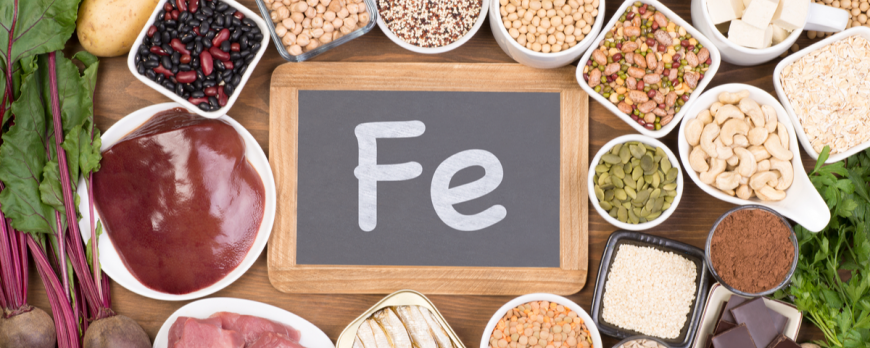Iron: Overview and Key Foods
Last updated onFebruary 3, 2022
Our body contains 3 to 4 g of iron, of which 70% is in the blood and 10% in the muscle. Iron is essential for the production of hemoglobin and myoglobin. Hemoglobin carries oxygen in the blood and myoglobin carries oxygen in the muscle. It is therefore quickly understood that a decrease in iron will have a negative impact on performance. Iron is also used in the synthesis of DNA and certain proteins, and it modulates dopamine and the production of noradrenaline. As a reminder, these two neurotransmitters are essential for good brain function, allowing us to achieve and maintain good concentration, good motivation, to make good decisions, to have good reflexes, and good motor skills.
Iron deficiency is common in Western countries, particularly among young women (due to blood loss from their periods). In Switzerland, 1 in 4 women are deficient, compared to 1 in 16 men.
Iron in athletes
Female athletes, but also male athletes, often lack iron for several reasons:
- Their diet is often not suited to their real needs.
- They often sweat a lot and can lose iron through sweat.
- They suffer from intestinal disorders that can cause iron loss in the stool.
- Athletes regularly experience problems with red blood cells (loss of blood in urine, even if it is not necessarily visible)
- The consumption of products containing caffeine, of which athletes are often fond
- They poorly absorb iron through the intestine, which often has too few good bacteria in its bacterial flora.
- A copper deficiency, common in athletes, prevents the normal assimilation of sugar.
- For runners, the impact of feet on the ground with each stride more easily breaks red blood cells (often low haptoglobin) and more easily loses iron.
All these reasons demonstrate that it is wise to regularly check your iron and ferritin levels, especially if you suffer from various clinical signs of deficiency: hair loss, weakened nails, chronic fatigue...
Iron in the diet
The solutions obviously involve diet and perhaps also supplementation, but be careful - an excess of iron is worse than a deficiency.Foods rich in iron include offal, red meat, poultry, seafood, fish and dried vegetables. You should always try to combine these foods with vegetables or fruits rich in vitamin C, which will allow for a better assimilation of iron!
Beware of caffeine! It inhibits the absorption of iron. Therefore, you should not drink coffee or tea within the hour before or after a meal composed of iron-rich foods (or the consumption of spirulina for example).
Discover our Recipe for lamb fillet with broad beans and artichokes, to get a full dose of iron.
And the spinach ?
Are spinach rich in iron? No! It’s a misconception in nutrition, dating back to 1870! At the time, a German biochemist (Emile von Wolff) mistakenly attributed them an iron content of 27 mg per 100 g, instead of the actual 2.7. A typo, therefore. But some 60 years later came Popeye, who allegedly became stronger after eating his spinach! And if the legend remains intact today, it is nonetheless erroneous.But the nutritional values of spinach are still interesting (rich in magnesium, vitamins A, B9, E, C, ...).
Iron supplementation
It's hard to talk about iron without mentioning spirulina. The WHO has proclaimed it as "the best food for humanity in the 21st century". Indeed, this microalgae (cyanobacteria) is particularly rich not only in iron but also in proteins, vitamins, minerals, and antioxidants.
Be sure to always consume it organic, without additives and from a slow drying method - which allows to preserve its nutritional richness.
Be sure to always consume it organic, without additives and from a slow drying method - which allows to preserve its nutritional richness.
Leave a Comment
Leave a Reply
Please login to post a comment.




